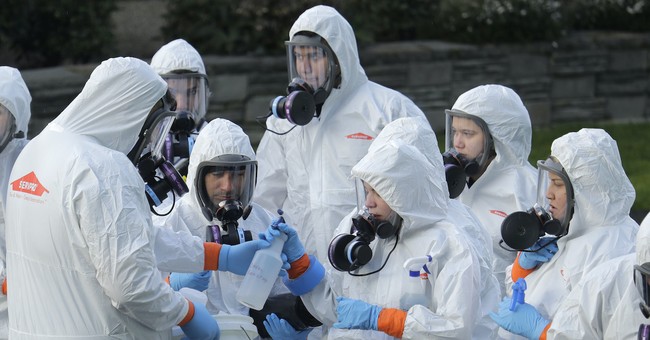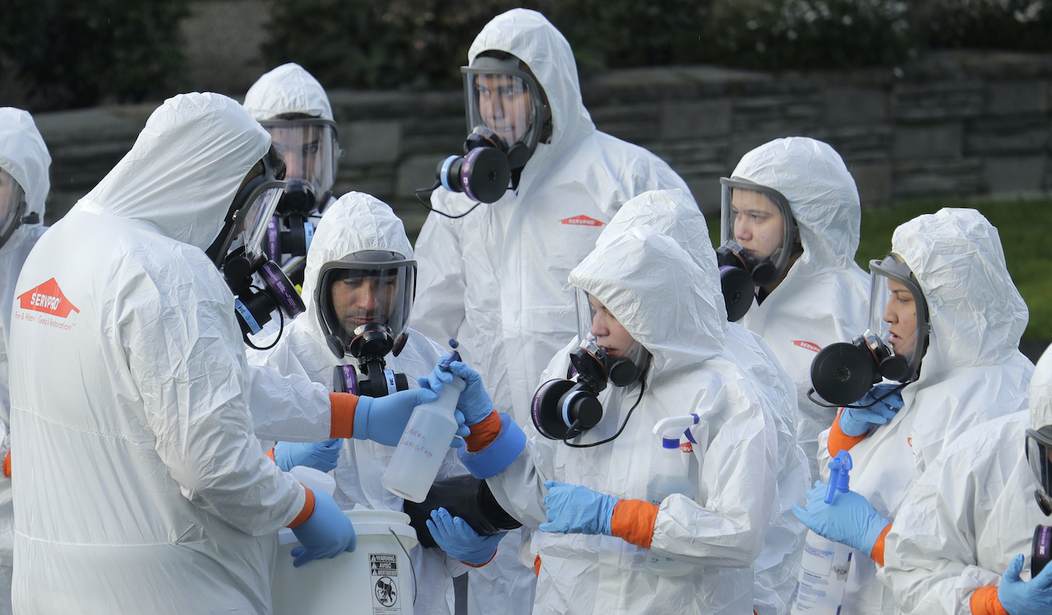
Workers from a Servpro disaster recovery team wearing protective suits and respirators are given supplies as they line up before entering the Life Care Center in Kirkland, Wash. to begin cleaning and disinfecting the facility, Wednesday, March 11, 2020, near Seattle. The nursing home is at the center of the outbreak of the COVID-19 coronavirus in Washington state. (AP Photo/Ted S. Warren)
As of April 15 at 6am, Sweden has 11,927 confirmed cases of COVID-19 and its death toll stands at 1,203. The country has adopted a low-key strategy to deal with the pandemic. Although the government encourages citizens to take precautions and to practice social distancing and some businesses have closed, the economy has largely remained open. Schools and restaurants in the country remain open. Gatherings of up to 50 people are allowed. For many, life throughout the crisis has been business as usual.
All eyes are on Sweden because of its government’s decision to eschew the far more rigorous standards the rest of the world is following. Critics refer to Sweden’s strategy as “herd immunity.”
Let’s see how Sweden is faring relative to their Nordic neighbors. Norway, Denmark and Finland have closed their borders, shut down schools, restaurants and other nonessential businesses. They’ve also limited outside gatherings to no more than ten people. They are in lock-down mode.
It’s important to note that Sweden has a population of 10.23 million, compared to Denmark with 5.77 million, Norway with 5.37 million and Finland with 5.52 million. So, for the sake of comparison, each of these countries has roughly half the population of Sweden.
Sweden has approximately twice as many total cases as the Norway and Denmark and four times as many as Finland.
As of today, Sweden had 482 new cases and 170 new deaths, compared to 63 new cases and 3 new deaths for Norway, 170 and 10, respectively for Denmark, and 76 new cases and no new deaths in Finland.
Total deaths in Sweden are 1,203. There have been 142 deaths in Norway, or 12% of Sweden’s total. Given that Sweden’s population is twice the size of Norway’s, this would be equivalent to 25% in Sweden. Denmark has had 309 total deaths or 26% of Sweden’s death toll. Adjusting for the population size, Denmark’s rate of death is equivalent to 52% of Sweden’s. Finland, being more isolated than the other countries has had only 64 deaths from COVID-19.
Sweden’s cases per million people, at 1,181, is remarkably in line with Norway (1,233) and Denmark (1,153). And it is twice as high as Finland’s.
Norway has tested more than three times as many people as Sweden, and Denmark, more than twice as many. Finland has tested a slightly higher number of people than Sweden.
(Note: Data Source: Worldometers)
Does this data, clearly unfavorable to Sweden, necessarily mean that the country has been wrong to adopt a “herd immunity” strategy? Did the government make a big mistake when they decided not to close schools and businesses throughout the country as most every other country has done?
Not necessarily.
In early March, when various plans of dealing with the coronavirus were being debated, the choices were shown to us via a curve. Two extremes were presented to us. In the first scenario, we could go on with business as usual and the curve would nearly immediately turn upward and would peak quickly. It would also fall as fast as it rose. The obvious disadvantage to this choice is that the hospitals would be crushed trying to provide care for such a huge number of patients at one time.
The second option, and the one the U.S. obviously chose was to shut down the economy and self-quarantine, the goal being to flatten the curve. The benefit to this plan was that our hospitals and health care professionals would not be overwhelmed. And, as we move through it, scientists have been working to find an effective therapy to fight the virus.
The number of lives lost was said to be approximately the same under the two plans, but the deaths would be accelerated under the first scenario.
Hot Air’s Allahpundit describes it this way:
Sweden’s strategy is to accept a short, severe outbreak in lieu of a much longer but maybe not much less severe one. Picture that famous graph in your mind showing how to “flatten the curve”: Sweden’s making a conscious decision to follow the taller, thinner curve in lieu of the shorter, fatter one. They’re supposed to have a big spike in deaths early; that’ll pay off for them, in theory, with many fewer deaths long-term as other countries are consumed with fighting off large second, third, and fourth waves of the disease. *If* you think “flattening the curve” is a pure matter of protecting hospital capacity, with little effect in reducing the final death toll from the disease over time, then arguably it’s better to go Sweden’s route and get it over with. It’ll be gruesome for them, but it’ll be gruesome for us too. It’ll just take longer for us.
He also points out that, according to the IHME model, Sweden’s “peak” is still four weeks away and by August 4, 18,000 more Swedes will die. “By population, that would be the equivalent of nearly 600,000 deaths in the United States, around 10 times as many dead as IHME projects for us by August.” Finally Allapundit adds:
Maybe you think that’s okay because of the accelerated timeline Sweden is aiming for. Conceivably they’ll be completely done with coronavirus by August while we’ll be gearing up for thousands more deaths this fall and winter — unless, of course, scientists discover an effective therapy between now and then that makes coronavirus much less lethal for us going forward. That’s the giant hole in Sweden’s “let’s get it over with” strategy. By not playing for time, they’re not giving medicine any chance to partially solve this problem for them. Imagine telling your citizens that they should carry on as usual in the name of herd immunity and accept that that means many thousands of deaths … and then, just as you’re finished burying the bodies and the outbreak is finally calming down, researchers announce great success with an experimental antiviral.
Sweden’s Minister of Health and Social Affairs Lena Hallengren told Vox reporter Alex Ward, “It is a myth that life goes on as normal in Sweden. Many people stay at home and have stopped traveling. There is no full lockdown of Sweden, but many parts of the Swedish society have shut down.” She offered some examples:
Ridership on public transportation in Stockholm has dropped about 60 percent, she said. Nearly all domestic flights in Sweden have been canceled. All the major ski resorts in the country have closed voluntarily. And local media reports that 85 percent of people who’d planned to travel to Gotland, a popular Swedish vacation island, have canceled their trips ahead of Easter weekend.
Hallengren added, “The government is ready to adopt stricter measures to combat the virus whenever we consider it necessary.”
Stockholm University political science professor spoke to Ward and agreed, saying, “A large majority are following the government’s advice. It’s pretty empty out there.”
But Ward was also told of stories where people were clearly not following even the loose requests of the government, one of which was that all gatherings be kept to a maximum of 500 people. This is not a typo. People were organizing events for 499 people. And bars continued to be open late into the night. The government responded by reducing the number of people allowed at outside gatherings to 50 which is still a large group and “by telling those at restaurants to sit only at tables, not stand crowded around the bar.”
Additionally, Ward writes that “one-third of all of Stockholm’s nursing homes have at least one case of the coronavirus.”
On the plus side, “Sweden’s health care system was better prepared than most for a major outbreak. Estimates vary among experts I spoke to, but the country’s health system likely has had somewhere between 500 and 1,000 beds available in hospital intensive care units. This follows a quick ramp-up from the government and lots of funding for a universal health system that’s considered top-tier worldwide, with well-trained physicians.”
It’s way too early to know if Sweden made a mistake by not adopting a stricter strategy. A small study in Chicago last week found that at least 30% of those they tested had immunity. The Daily Wire reported on that here. Certainly, if people in Sweden have been attending gatherings with 499 people and visiting bars, we would expect their immunity levels to be higher.
This pandemic has been virgin territory for every government. It would have helped if China hadn’t kept the world in the dark for so long. Leaders can only act on the information that is currently available, making adjustments as new discoveries, drugs, and information come along. The world is still in the middle of this crisis and it is only with hindsight that we can draw any meaningful conclusions.














Join the conversation as a VIP Member